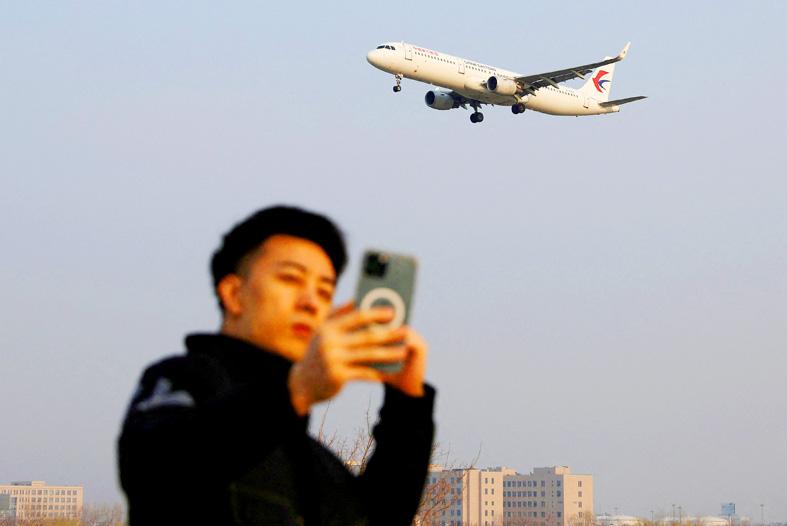China Eastern Airlines Corp (中國東方航空) has resumed flights using the same type of plane that recently crashed in southern China, a sign that it is working toward putting the entire fleet back in the air.
A 737-800 jet flew from Kunming to Chengdu on Sunday, according to flightradar24.com.
Other planes of the same model made by Boeing Co have been used in what appeared to be test flights, including near Shanghai.

Photo: Reuters
Xinhua news agency yesterday reported that the airline has returned the 737-800 to commercial service, without saying how it got the information.
Planes with similar registration numbers to the one that went down on March 21 killing all 132 people on board were still being evaluated, it said.
China Eastern grounded more than 200 of the Boeing 737-800 planes after the crash in Wuzhou, in the Guangxi region. Flight 5735 from Kunming to Guangzhou was cruising at about 8,840m when it suddenly dove, slamming into a forested hillside about 160km from its destination.
Investigators retrieved the two “black boxes” from the crash site — one that recorded voices in the cockpit and another that captured flight data — and sent them to the US. The hope is that information on the devices will help solve the mystery of what happened to the jet, which disintegrated into tens of thousands of pieces on impact.
A preliminary report is to be produced this week, as required by UN standards governing the aviation industry, and a full report is expected within 12 months.

Taiwan Semiconductor Manufacturing Co (TSMC, 台積電) last week recorded an increase in the number of shareholders to the highest in almost eight months, despite its share price falling 3.38 percent from the previous week, Taiwan Stock Exchange data released on Saturday showed. As of Friday, TSMC had 1.88 million shareholders, the most since the week of April 25 and an increase of 31,870 from the previous week, the data showed. The number of shareholders jumped despite a drop of NT$50 (US$1.59), or 3.38 percent, in TSMC’s share price from a week earlier to NT$1,430, as investors took profits from their earlier gains

In a high-security Shenzhen laboratory, Chinese scientists have built what Washington has spent years trying to prevent: a prototype of a machine capable of producing the cutting-edge semiconductor chips that power artificial intelligence (AI), smartphones and weapons central to Western military dominance, Reuters has learned. Completed early this year and undergoing testing, the prototype fills nearly an entire factory floor. It was built by a team of former engineers from Dutch semiconductor giant ASML who reverse-engineered the company’s extreme ultraviolet lithography (EUV) machines, according to two people with knowledge of the project. EUV machines sit at the heart of a technological Cold

Taiwan’s long-term economic competitiveness will hinge not only on national champions like Taiwan Semiconductor Manufacturing Co. (TSMC, 台積電) but also on the widespread adoption of artificial intelligence (AI) and other emerging technologies, a US-based scholar has said. At a lecture in Taipei on Tuesday, Jeffrey Ding, assistant professor of political science at the George Washington University and author of "Technology and the Rise of Great Powers," argued that historical experience shows that general-purpose technologies (GPTs) — such as electricity, computers and now AI — shape long-term economic advantages through their diffusion across the broader economy. "What really matters is not who pioneers

TAIWAN VALUE CHAIN: Foxtron is to fully own Luxgen following the transaction and it plans to launch a new electric model, the Foxtron Bria, in Taiwan next year Yulon Motor Co (裕隆汽車) yesterday said that its board of directors approved the disposal of its electric vehicle (EV) unit, Luxgen Motor Co (納智捷汽車), to Foxtron Vehicle Technologies Co (鴻華先進) for NT$787.6 million (US$24.98 million). Foxtron, a half-half joint venture between Yulon affiliate Hua-Chuang Automobile Information Technical Center Co (華創車電) and Hon Hai Precision Industry Co (鴻海精密), expects to wrap up the deal in the first quarter of next year. Foxtron would fully own Luxgen following the transaction, including five car distributing companies, outlets and all employees. The deal is subject to the approval of the Fair Trade Commission, Foxtron said. “Foxtron will be